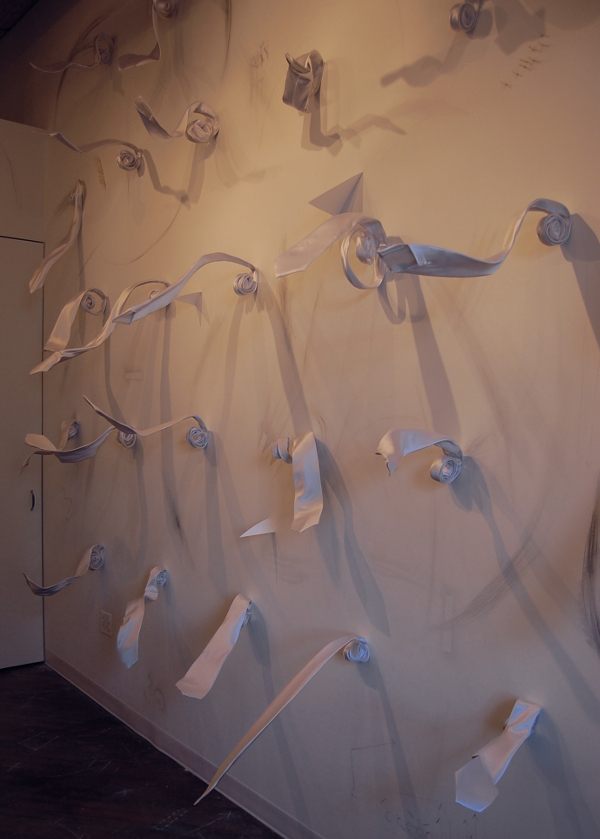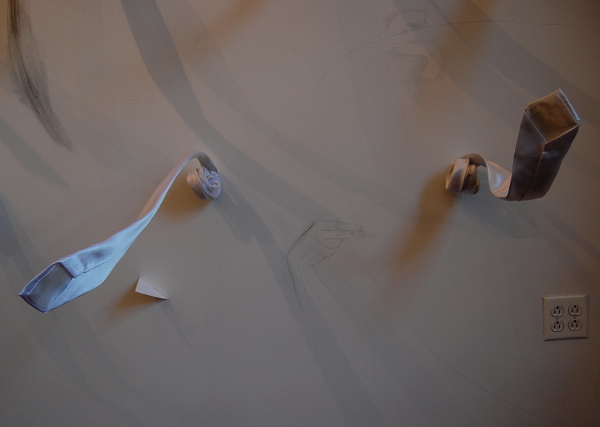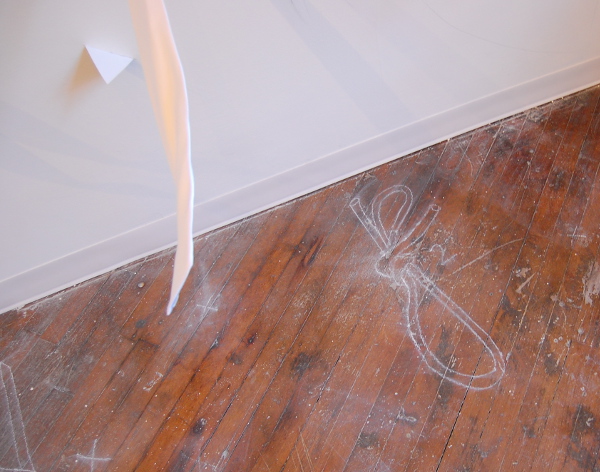
Kris Strawser confronts the power structures of neckties at Napoleon
Neckties are as much a garment as they are a symbol. These less-than-pragmatic scarves wind around the neck of the wearer to signify gender (or potentially its upending), class and high fashion all tied into one. At Napoleon, artist Kris Strawser examines the social role of the tie, the medium of drawing, and the color white with her installation entitled “Switch.”
Rarely would it seem likely for the focus of a room-sized installation to be a two-dimensional medium like drawing, but the interior of Napoleon looks as much like a sketchbook as it does a sculptural creation. Initially the neckties unfurling from the walls and sticking into the space like some type of booby trap demand all the attention, but as one spends a bit more time within, the intricacies between each spike of fabric emerge to tell a more detailed story.
Sign language gestures signal to us from between the slivers of fabric.
Strawser fills in the gaps with her own personal markers which include letters of the alphabet, hands in various signing gestures, apparent football play diagrams, and some tie-tying demonstrations that sometimes look eerily like a hangman’s knot. The artist herself claims that these inclusions are personal and not necessarily meant to be consciously understood, but they certainly offer us a rough contextual basis to work with.
Mysterious sketchbook-like drawings and diagrams like this football play chart offer more questions than they answer…
On the wall, the images are drawn with graphite, while on the wooden floor they are composed of white chalk not unlike the idea of outlines surrounding bodies at crime scenes. An installation first deemed to reference stuffy business attire suddenly begins to build up a series of grisly implications. Sometimes called an ‘upside down noose’, these accessories do tend to represent an oppressive society built around profit and constrictive social classes. If one considers gender more fluid than the male/female binary split, then the masculinity of the tie might also call to mind the boxing in of identity or rampant patriarchal tendencies.
By providing these snaking forms prodding toward the viewer no matter where in the gallery they take refuge, we are reminded of the organization of our society that often takes benign forms in our everyday life, despite the sometimes violent or oppressive truths it represents. When we don neckties, do we ever give second thought to what they might otherwise stand for?
Sometimes the knots here resemble something more morose than neckties.
Through a diminished palette of pure white, Strawser seems to offer us a blank canvas. She encourages us to consider a fresh start in a present which, in many ways, was constructed far before we ever had a say in it. Instead of wallowing in the downfalls around us, however, Strawser keeps her attitude resilient and positive. No matter the hand we’ve been dealt, each of us has the opportunity to do good deeds and achieve progress on a daily basis.
We are oftentimes challenged when we least expect it, and for those of us wearing the uniforms of capitalism on a daily basis, Strawser throws us for a loop by presenting our accoutrements as a vehicle for the power structures that be. Should we tie dye these cloths or merely loosen them when we leave work? Do we allow this apparel to become a leash, or can we wear it merely as an article of professional clothing? Should we reject this badge altogether?
Regardless of our take on the subject, Kris Strawser inundates us with neckties and sketches that call us to contemplation about the roles we play in society. “Switch” will be on display at Napoleon through May 25.
Napoleon is located at 319 North 11th St., on the 2nd floor, Philadelphia; [email protected]; napoleonnapoleon.com.
Recent Content
-
Artsarticle ·
-
Artsarticle ·
-
Artsarticle ·




